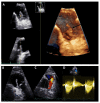The Role of Multimodality Imaging in Patients with Congenital Heart Disease and Infective Endocarditis
- PMID: 38132222
- PMCID: PMC10742664
- DOI: 10.3390/diagnostics13243638
The Role of Multimodality Imaging in Patients with Congenital Heart Disease and Infective Endocarditis
Abstract
Infective endocarditis (IE) represents an important medical challenge, particularly in patients with congenital heart diseases (CHD). Its early and accurate diagnosis is crucial for effective management to improve patient outcomes. Multimodality imaging is emerging as a powerful tool in the diagnosis and management of IE in CHD patients, offering a comprehensive and integrated approach that enhances diagnostic accuracy and guides therapeutic strategies. This review illustrates the utilities of each single multimodality imaging, including transthoracic and transoesophageal echocardiography, cardiac computed tomography (CCT), cardiovascular magnetic resonance imaging (CMR), and nuclear imaging modalities, in the diagnosis of IE in CHD patients. These imaging techniques provide crucial information about valvular and intracardiac structures, vegetation size and location, abscess formation, and associated complications, helping clinicians make timely and informed decisions. However, each one does have limitations that influence its applicability.
Keywords: cardiac computed tomography; cardiac magnetic resonance imaging; congenital heart disease; echocardiography; infective endocarditis; multimodality imaging; nuclear imaging.
Conflict of interest statement
The authors declare no conflict of interest.
Figures




References
-
- Habib G., Erba P.A., Iung B., Donal E., Cosyns B., Laroche C., Popescu B.A., Prendergast B., Tornos P., Sadeghpour A., et al. Clinical presentation, aetiology and outcome of infective endocarditis. Results of the ESC-EORP EURO-ENDO (European infective endocarditis) registry: A prospective cohort study. Eur. Heart J. 2019;40:3222–3232. doi: 10.1093/eurheartj/ehz620. Erratum in Eur. Heart J. 2020, 41, 2091. - DOI - PubMed
-
- Baddour L.M., Wilson W.R., Bayer A.S., Fowler V.G., Jr., Tleyjeh I.M., Rybak M.J., Barsic B., Lockhart P.B., Gewitz M.H., Levison M.E., et al. Infective Endocarditis in Adults: Diagnosis, Antimicrobial Therapy, and Management of Complications: A Scientific Statement for Healthcare Professionals from the American Heart Association. Circulation. 2015;132:1435–1486. doi: 10.1161/CIR.0000000000000296. Erratum in Circulation 2015, 132, e215. Erratum in Circulation 2016, 134, e113. Erratum in Circulation 2018, 138, e78–e79. - DOI - PubMed
Publication types
LinkOut - more resources
Full Text Sources

